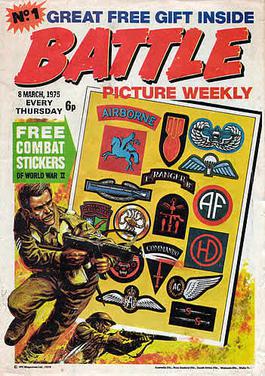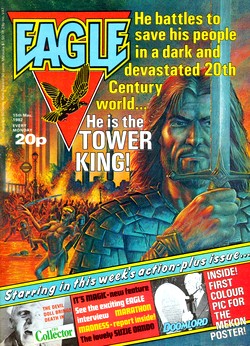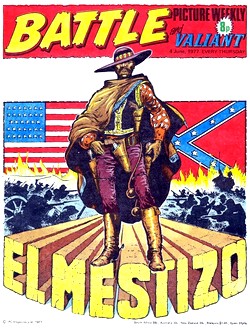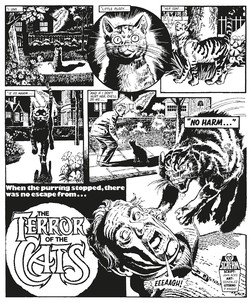
Crisis was a British comic anthology published by Fleetway Publications from 17 September 1988 to October 1991, initially fortnightly and later monthly. Designed to appeal to older readers than other Fleetway titles in order to take advantage of a boom in interest in 'adult' comics, Crisis featured overtly political and complex stories; one issue was even produced in conjunction with Amnesty International.

Battle Picture Weekly was a British weekly boys' war comic published by IPC Magazines from 8 March 1975 to 23 January 1988, when it merged with the new incarnation of Eagle after 644 issues. Most stories were set in World War II, with some based on other conflicts, while factual features also focused on warfare.

Starlord was a British weekly boys' science fiction comic published by IPC Magazines from 13 May to 7 October 1978, when it merged with 2000 AD after 22 issues. The comic was created by Kelvin Gosnell, and was originally intended as a fortnightly sister title for 2000 AD with higher production values and an older audience, but late changes in production saw it converted into a weekly.

"The Thirteenth Floor" is a British science fiction strip character, appearing in titles published by IPC Magazines. The strip debuted in the weekly anthology Scream! on 24 March 1984, before continuing in Eagle until 28 February 1987. The stories were written by John Wagner and Alan Grant; art was provided by José Ortiz. Since 2016 the property has been owned by Rebellion Developments, who have revived the strip in several specials. The plot was set in a tower block called Maxwell Tower, controlled by an experimental sentient computer called Max located on the 13th floor of the flats. Max himself narrated the strip, and as befitting a computerised custodian of hundreds of people, was quite chatty and light-hearted. However, he was also portrayed as having a programming flaw; programmed to love and protect his tenants, he could remorselessly kill anyone who threatened or even just annoyed them.

"The Tower King" is a British comic strip, appearing in titles published by IPC Magazines. The story was published in the anthology Eagle from 27 March to 4 September 1982, written by Alan Hebden, with art by José Ortiz. The story was set in a dystopian London, where society has broken down.

Tornado was a British weekly boys' adventure comic published by IPC Magazines from 24 March to 18 August 1979. The comic was partly created as a way to use up stories already commissioned for the other titles, and was marred by a difficult production. Tornado sold poorly and was merged with 2000 AD after 22 issues.

Major Eazy is a British comic character, appearing in strips published by IPC Magazines. Eazy featured British comic war stories published in the weekly anthology Battle Picture Weekly from 10 January 1976 to 10 June 1978, written by Alan Hebden and drawn by Carlos Ezquerra. Set during World War II, the strips follow Eazy, an unconventional British Army officer with a laidback attitude.

"The Dracula File" is a British comic horror strip published by IPC Magazines and Rebellion Developments. It debuted in the first issue of the weekly anthology comic Scream on 24 March 1984. The story was written by Gerry Finley-Day and later Simon Furman, and was drawn by Eric Bradbury. The story featured Count Dracula escaping from the Eastern Bloc at the height of the Cold War before appearing in modern-day England, with KGB Colonel Stakis in pursuit. Scream was short-lived, being merged into Eagle in June 1984 after only 15 issues.

"Hellman of Hammer Force" is a British comic strip published by IPC Magazines in the boys' comic anthology titles Action and later Battle between 14 February 1976 and 8 July 1978. The story was set in World War II; while war comics were common material in British comics of the time, "Hellman of Hammer Force" was rare for its use of a sympathetic Wehrmacht officer as the lead protagonist. While not as controversial as fellow Action stories such as "Kids Rule O.K." and "Hookjaw" it was nevertheless caught up in the campaign against the title by the British tabloid press.

"The Bootneck Boy" is a British comic war story published in the weekly anthology Battle Picture Weekly from 8 March 1975 to 12 November 1977 by IPC Magazines. Set during World War II, the story follows Danny Budd, a youth from the fictional Northern England town of Tynecastle as he strives to join the Royal Marines.

"Clash of the Guards" is a British comic war story published in the weekly anthology Battle from 26 September 1981 to 23 April 1983 by IPC Magazines. Set during World War II, it follows the experiences of Brad Clash, a fictional American stuntman turned 6th Corps soldier assigned to pick up tips from a company of British Guards in Italy.

"Death Squad" is a British comic war story published in the weekly anthology Battle from 12 July 1980 to 4 June 1981 by IPC Magazines. Set during World War II, the story follows a Wehrmacht penal military unit spared death sentences in return for service on the Eastern front. It was written by Alan Hebden and drawn by Eric Bradbury.

"Johnny Red" is a British comic war story published in the weekly anthology Battle Picture Weekly from 29 January 1977 to 17 January 1987 by IPC Magazines. Set during World War II, the story follows Johnny 'Red' Redburn, a British pilot leading the Falcon Squadron unit of the Soviet Air Forces on the Eastern Front. Written by Tom Tully and initially drawn by Joe Colquhoun, the strip was the longest-running in Battle's history, only ending in 1987 when financial constraints saw it switched to reprints.

"El Mestizo" is a British comic war story published in the weekly anthology Battle Picture Weekly from 4 June to 17 September 1977 by IPC Magazines. Set during the American Civil War, the story follows a mestizo slave turned mercenary returning from Mexico to America in 1862. The story was written by Alan Hebden and drawn by Carlos Ezquerra.

"Rat Pack" is a British comic war story published in the weekly anthology Battle Picture Weekly from 8 March 1975 to 8 July 1978 by IPC Magazines. Set during World War II, the story follows the eponymous unit, a penal military unit of four criminals recruited by British Army officer Major Taggart to undertake deadly missions.

"Dredger" is a British comic action story published in the weekly anthologies Action and Battle Action from 14 February 1976 to 7 October 1978 by IPC Magazines. The strip focused on the eponymous, uncompromising secret agent and his partner Breed, featuring self-contained stories that featured Dredger getting out of lethal situations with an innovative and violent approach.

Eagle, sometimes referred to as The New Eagle and known at various points in its life as Eagle and Scream!, Eagle and Tiger, Eagle and Battle, Eagle and M.A.S.K. and Eagle and Wildcat, was a British boys' adventure comic published by IPC Magazines from 27 March 1982 to January 1994. A revival of the famous Eagle, the title was initially a weekly publication until turning into a monthly in May 1991. The title was finally cancelled in January 1994, after 505 issues.

"Terror of the Cats" is a British horror comic strip character, appearing in titles published by IPC Magazines. The strip was published in the weekly anthology Scream! from 24 March to 28 April 1984. The story was initially written by Chris Lowder before he quit, with Simon Furman taking over; it was Furman's first published comics work. José Gonzalez and John Richardson provided artwork. The story concerns housecats suddenly becoming hostile to humans.

"The Nightcomers" is a British science fiction strip character, appearing in titles published by IPC Magazines. The strip debuted in the weekly anthology Scream! on 5 May 1984, running until the comic was cancelled after the 30 June 1984 edition. The story was written by Tom Tully and drawn by John Richardson.



















